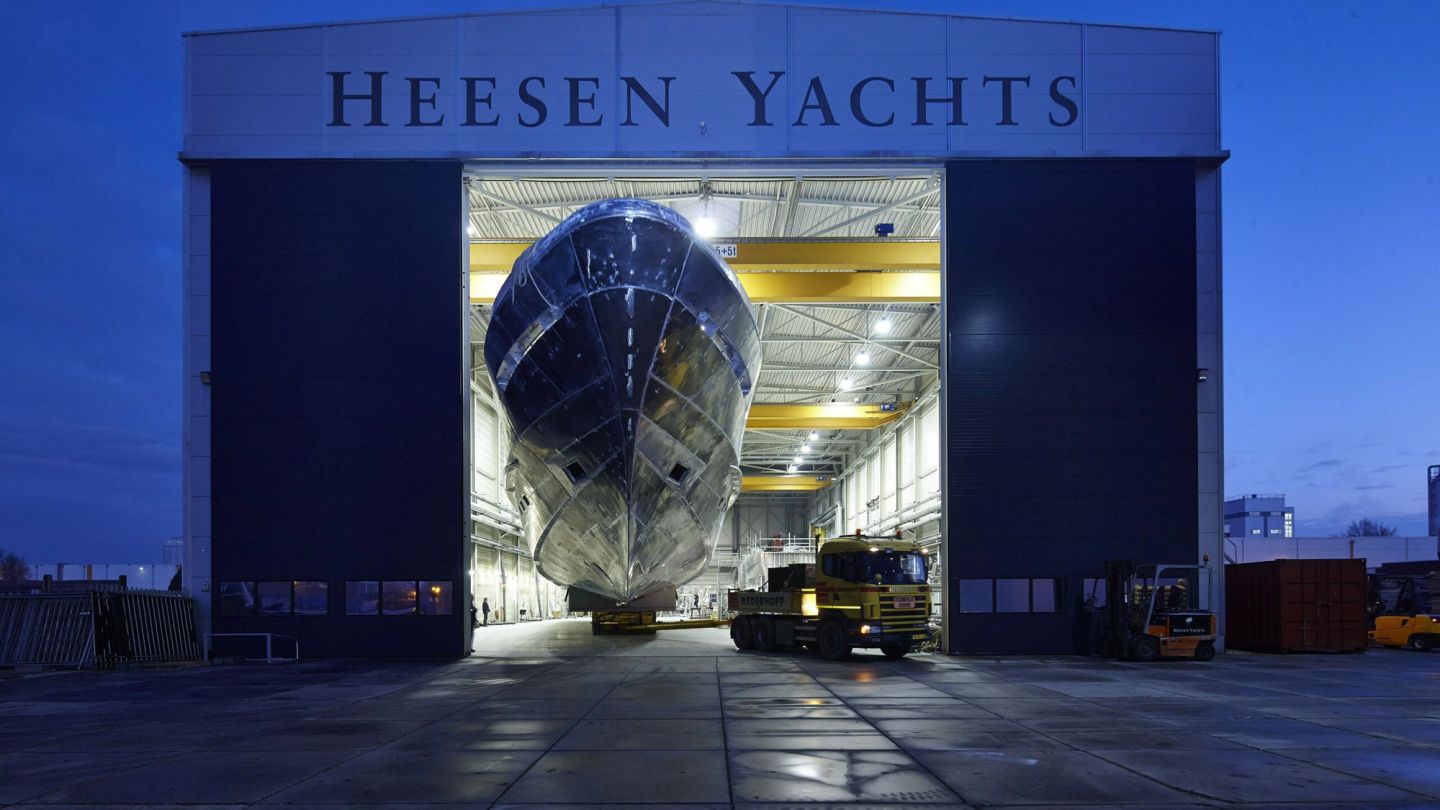

Words: Gentleman's Journal
Best known for their displacement motor yachts, the Dutchmen at Heesen have always been dedicated to pushing the boundaries in design and build. This is partly because the yard’s founder, Frans Heesen, began his career in the hi-tech plastics industry before moving into yachting. During the 1960s and 1970s, plastics were giving Silicon Valley a run for its money in the use of modern technology to overcome previously insurmountable manufacturing problems.
While Steve Jobs was building the first Mac in a garage in Los Altos, Frans was figuring out how to make a 250-tonne superyacht do 50 knots in another much larger garage (well, warehouse) in Holland.
It was this pioneering spirit and can-do attitude that made Frans, and Heesen Yachts, the only shipyard in the world brave enough to take on John Staluppi’s Octopussy project. This 1985 challenge was for any shipyard to build a large yacht that would travel at more than 50 knots, a speed which at the time was nearly double what any yacht had been capable of.
The penalty for failure would likely have been bankruptcy for the shipyard concerned, since not achieving the speed would have constituted grounds for rejection of the vessel, leaving the shipyard with a multi-million-dollar white elephant. As a result, shipyard after shipyard declined the challenge until Frans Heesen took a gamble that his engineering ingenuity would overcome the technical challenges. The rest is history.
"While Steve Jobs was building the first Mac in a garage in Los Altos, Frans was figuring out how to make a 250-tonne superyacht in a much larger garage..."
Today the technological issues are very different, but just as complex and challenging. These days Heesen are leading the way in their efforts to meet owners’ demands for fast but fuel-efficient large motor yachts, delivering award-winning vessels that combine speed and style, and which use the space in more innovative ways.
The 65-metre Galactica Star is one such example of modern yacht design that takes innovation and fuel economy to a whole new level. Combining a 20-knot cruising speed with a range of 4,200 nautical miles, and a top speed above 28 knots with throttles wide open, Galactica Star is more than 30 per cent more efficient than a traditional superyacht of the same size.
This is due to her incredibly efficient hull design, which means that less power is required throughout the speed curve, which of course means less fuel is burned. She was the first incarnation of Heesen Yachts Fast Displacement Hull Form. Developed for Heesen by Dutch naval architects Van Oossanen, the revolutionary Fast Displacement Hull Form technology bridges the divide between speed and range.
Traditionally, if you wanted a fast yacht you would be sacrificing volume and efficiency at lower speeds, as faster yachts only reach their maximum efficiency at high speeds as they plane over the surface of the water. Their use is also very limited by weather, as operating a planing hull in a heavy sea at too high a speed for the conditions can be highly dangerous; while operating the same shallow craft at slow speeds in a big swell will give her passengers’ stomachs a testing time.,
Lighter is better, but can mean a consequent lack of space below deck as the draft needs to be shallow and the majority of hull volume lies above the surface, much like a reverse iceberg. Traditional full-displacement yachts, meanwhile, come with greater volume below deck and a longer range; just like commercial ships, they’ll run efficiently at low speeds, pushing or displacing the water to either side with their hull.,

Beyond a certain point, though, adding more engine power becomes counter-productive; rather than rising onto the surface of the water, the application of more horses to the drive train will only cause the hull to ‘squat’ down. This makes it less efficient, while also causing the fuel bill to rise. This can be mitigated by making the bow section shallower (a hull form known as ‘semi’-displacement), but this is generally not efficient at either end of the fuel/speed curve. The amount of power required to get those extra few knots isn’t considered worthwhile by their owners, who tend to operate these yachts in the more efficient displacement mode for 99 per cent of the time.
The Fast Displacement Hull Form is still a displacement hull form, but its ‘slippery’ nature and clever design means that Heesen are able to offer a more linear speed/efficiency curve. As a result, the hull requires less power to maintain the same speed, and that means smaller engines, which burn less fuel and take up less space, leaving more for the guests. Galactica Star, for example, boasts a 20m sun deck, a duplex beach club that occupies 25 per cent of the main and lower decks, and a touch-and-go helipad on the foredeck. Sleeping 12 guests, she has a full-beam master suite with private balcony, and a VIP suite on the upper deck. Hardly cramped.
Following in the footsteps (or perhaps the wake) of Galactica Star, the 70m Galactica Super Nova, delivered in 2016, took the Fast Displacement Hull Form a small step further. With an extra engine on board, she really tests the limits of hull speed and at full throttle is capable of up to 30 knots.
But like its predecessor, Galactica Super Nova is not a semi-displacement yacht, and also runs as a displacement hull, whereby the bow pushes the water to either side rather than lifting and planing on top of the water after a certain speed.
The main difference is that her hull shape and its entry through the water allows higher speeds with the application of more power (and no squatting). Therefore at 12 knots she still has a range of 4,000 nautical miles, which is comparable with a normal full-displacement yacht. But she can still do 30 knots if several enormous herds of horses are placed at her disposal.
The best of both worlds on the technical front, then. But beyond her remarkable and groundbreaking technical performance, Galactica Super Nova also boasts a head-turning exterior designed by the renowned naval architect Espen Øino. The designer was able to further develop the profile that embodies the Heesen DNA with the introduction of subtle design elements to make Galactica Super Nova one of the most impressive-looking superyachts afloat. With 357 square metres of deck space, including a vast sun deck and beach club, she is the equal of any conventional full-displacement yacht, but with the advantage of long-range cruising capabilities and the ability to go faster than just about any other 70m. A true tick-every-box superyacht.
"Ready for yachting’s summer season, Project Nova is the first fast displacement all-aluminium build, and boasts a reduced environmental impact thanks in part to her hybrid propulsion system..."
Never keen to rest on their laurels, however, 2017 will be no different for Heesen Yachts. Ready for yachting’s summer season, Project Nova is the first fast displacement all-aluminium build, and boasts a reduced environmental impact thanks in part to her hybrid propulsion system.
Previous hybrid yachts have used a diesel electric power base, with expensive lithium-ion batteries for storing excess power produced by the yacht’s diesel generators. But rather than being either all conventional diesel-mechanical or all diesel-electric with batteries, Project Nova offers both. And rather than focusing on top speed, although she reaches a very respectable 16.3 knots, Project Nova is really designed for her night job as a silent eco-assassin. Two shaft-driven electric motors will allow her to power through the waves at up to nine knots without even using her main engines, and will mean that the noise generated is equivalent to the sound of softly falling rain – ideal for those night-time cruises with guests tucked up below deck.
Consuming around 26 US gallons of fuel per hour at cruising speeds and just 18 at economical speeds, she is the most fuel-efficient vessel in her class. With main engines running, however, and more speed required, the electric motors can also be used to provide free electricity to the yacht. Working all together with everything on full, they can provide a boost speed of up to 16 knots. And no need for those expensive lithium-ion battery banks that eventually need replacing.
Once again, Heesen has not stinted on the design of this extraordinary vessel. Her ultra-modern profile boasts a vertical stern that looks radical on the water, while the design throughout is inspired from open-air beach villas. Panoramic glass walls offer unblemished views, while the interior is light and airy, designed to bring the outdoors in.
Perfection in any form of technology or construction can never be achieved without the passion to innovate and always be at the forefront, and Heesen has it in spades. If you’re looking for the impossible, look no further.


